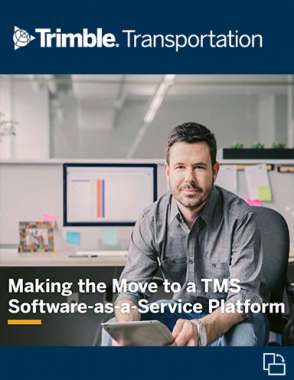Connected Maintenance and its Role in the Supply Chain

We caught up with Renaldo Adler, Trimble’s head of software engineering, connected maintenance, to get a snapshot of how connected maintenance technologies can help address the tight equipment and labor markets.
Connected Maintenance in a Tight Equipment Market: Q&A with Renaldo Adler
Maintenance has always played an important role in the supply chain. During times like these, maintenance is even more critical, with long lead times and high costs for new heavy-duty trucks – and at the same time, the used vehicle market is very tight.
What these market conditions mean is that fleets must stay on top of maintenance activities such as preventive maintenance to keep equipment running smoothly so freight is delivered on time and drivers can continue working and getting paid.
We caught up with Renaldo Adler, Trimble’s head of software engineering, connected maintenance, to get a snapshot of how connected maintenance technologies can help address the tight equipment and labor markets.
Nice to talk to you again, Renaldo! What is new in connected maintenance since we last chatted?
There is a lot going on! We are excited that things seem to be opening up a bit more for in-person visits, trade shows, and conferences. And with all of the interest in the supply chain right now, there is a lot of enthusiasm for figuring out how we can work together to help with the challenges.
Our team is focused on a few areas and integrations to help address some of these supply chain issues. We’re hearing a lot of requests for DVIR pre-trip and post-trip inspections to simplify and improve the driver experience – which we all know is crucial right now. We’re looking for all the ways we can to help drivers get trucks fixed better, faster, and sooner.
Another thing we’re focused on is enhancing the ways that fleets work with service providers – those who are fixing trucks while they’re on the road vs. in-house. We want to make that data connection as seamless as possible to get trucks back out on the road faster.
We work closely with our customers to solicit feedback and hear directly from them about the challenges they’re facing, and building integrations for enhanced data connections are at the top of their list!
What benefits can fleets realize from connected maintenance solutions in this tight new & used vehicle market?
With the various supply chain issues right now, it’s hard to get new trucks, and it’s nearly impossible to find good used trucks. So, maintenance is more important than ever before – fleets need to keep equipment longer, and the older a truck is, the greater the chance that it will break down or have other maintenance issues.
That’s why being able to predict those maintenance needs and do repairs proactively is of immense value. We can help fleets through predictive analytics to identify possible breakdowns and other issues and avoid them altogether. Having advanced knowledge of which parts will need to be replaced is also hugely valuable right now from an inventory standpoint due to extended lead times and backorders on parts.
It's ironic, in a way – in our current supply chain environment, it’s not uncommon that the parts needed to repair trucks to ease the supply chain crunch are stuck somewhere in the supply chain!
Do you think connected maintenance could help address labor issues such as the driver and/or technician shortage?
Oh, definitely. From a driver retention perspective, there are a few things to keep in mind. First, drivers like to drive new trucks. Right now, if a fleet can’t get a driver in a new truck, they should at least be focused on making sure the trucks are maintained and running smoothly. And next best, drivers want to earn a living, just like the rest of us. If their truck is in the shop, they’re not making money.
On the technician side, we also are focused on creating a great user experience and helping make the position more attractive to potential recruits. We are currently working on a new tablet-based solution for technicians that looks and feels more like a tablet or phone they’re accustomed to using in their personal lives, catering to the next generation of technicians who are more tech-savvy.
This mobile solution allows them to quickly access the information they need such as parts inventory, a vehicle’s repair history, provide repair updates to the fleet and/or driver, and much more, all while they’re moving around the shop and vehicle – no need to go back and forth between a kiosk and the truck.
At Trimble, we’re always looking for ways to improve the user experience – for example, improving communications between the driver, operations, managers, service providers, etc., so that in the event there is an issue, all parties feel it is being addressed as quickly as possible and is kept in the loop about what’s going on.
We’ve been hearing a lot of buzz around how fleets determine how much of their maintenance activities to outsource vs. keep in-house. Do you have any insights on this?
Overall, the trend is that more and more fleets are outsourcing work. As fleet assets become more complex and “smarter,” we see fleet shops struggling to stay current with the new technology on trucks.
Extended warranty programs drive repairs to dealer networks, and the technician shortage has fleets rethinking standard internal repairs such as oil changes. In some cases that work is outsourced and technician capacity is redirected to the inspection process and associated repairs.
As fleet assets begin to age due to replacement cycles increasing, the maintenance requirements rise, once again constraining the available internal shop capacity and outsourcing becomes more attractive.
Trimble’s TMT Fleet Maintenance solution gives fleets the ability to monitor fleet health in real-time. Through the repair order creation process, whether internal repair or external repair, TMT alerts the fleet to Preventive Maintenance services coming or overdue, warranty status of the asset, job, or part, and if a chronic repair situation exists. This information allows the fleet to make informed decisions about where the service should occur.
What makes Trimble’s approach to maintenance solutions unique?
Trimble Transportation has a product that serves every part of the supply chain. We have navigation, telematics, video, operations, dispatch, maintenance, analytics, procurement and so much more.
Our business units work together closely to connect the supply chain using these technologies, and the more we can connect them to provide a unified solution, the better the experience is for our customers – a true one-stop-shop.
Because of this, we are always looking for ways to not only connect our solutions internally to other Trimble solutions, but also to external parties to serve the entire industry.
To learn more about Trimble’s connected maintenance solutions, visit Trimble Transportation's Industry Leading Asset Maintenance Software.
Article Topics
Trimble News & Resources
Trimble acquires Transporean in major deal, for nearly $2 billion Transportation & Logistics Companies Gain Significant Benefits from Technology Investments Making the Move to a Transportation Management System Software-as-a-Service Platform 4 Reasons Your Fleet Needs Video Technology Guide to Maximizing Your Fleet Management ROI Connected Maintenance and its Role in the Supply Chain Mitigating Risk and Improving Trucking Safety with Enhanced Video Intelligence More TrimbleLatest in Transportation
The Two Most Important Factors in Last-Mile Delivery Most Companies Unprepared For Supply Chain Emergency Baltimore Bridge Collapse: Impact on Freight Navigating Amazon Logistics’ Growth Shakes Up Shipping Industry in 2023 Nissan Channels Tesla With Its Latest Manufacturing Process Why are Diesel Prices Climbing Back Over $4 a Gallon? Luxury Car Brands in Limbo After Chinese Company Violates Labor Laws More Transportation
















